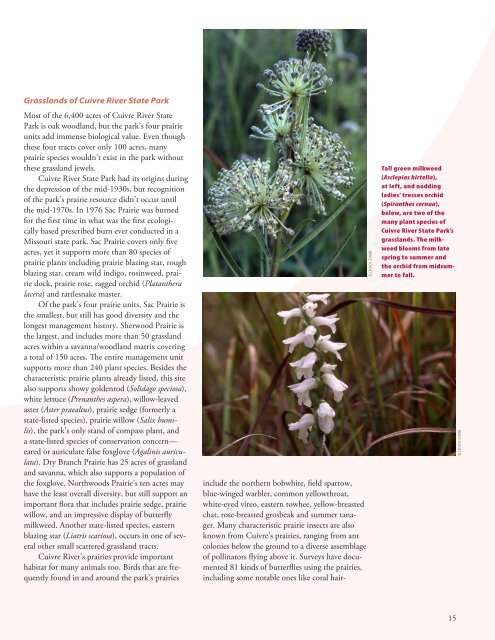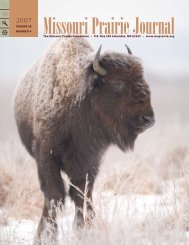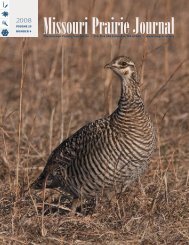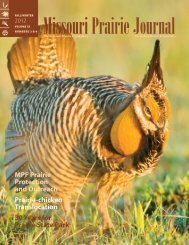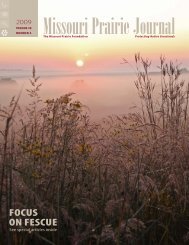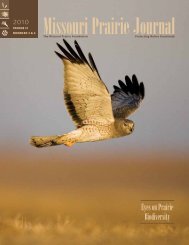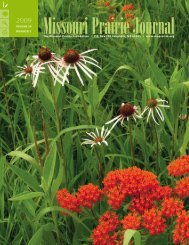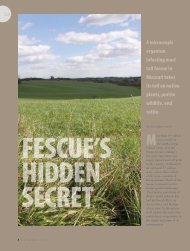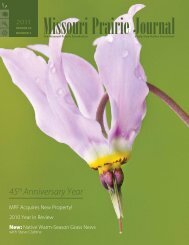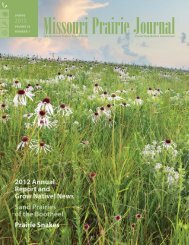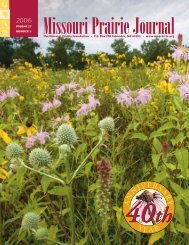Summer 2007: Volume 28, Number 3 - Missouri Prairie Foundation
Summer 2007: Volume 28, Number 3 - Missouri Prairie Foundation
Summer 2007: Volume 28, Number 3 - Missouri Prairie Foundation
- No tags were found...
You also want an ePaper? Increase the reach of your titles
YUMPU automatically turns print PDFs into web optimized ePapers that Google loves.
Grasslands of Cuivre River State ParkMost of the 6,400 acres of Cuivre River StatePark is oak woodland, but the park’s four prairieunits add immense biological value. Even thoughthese four tracts cover only 100 acres, manyprairie species wouldn’t exist in the park withoutthese grassland jewels.Cuivre River State Park had its origins duringthe depression of the mid-1930s, but recognitionof the park’s prairie resource didn’t occur untilthe mid-1970s. In 1976 Sac <strong>Prairie</strong> was burnedfor the first time in what was the first ecologicallybased prescribed burn ever conducted in a<strong>Missouri</strong> state park. Sac <strong>Prairie</strong> covers only fiveacres, yet it supports more than 80 species ofprairie plants including prairie blazing star, roughblazing star, cream wild indigo, rosinweed, prairiedock, prairie rose, ragged orchid (Platantheralacera) and rattlesnake master.Of the park’s four prairie units, Sac <strong>Prairie</strong> isthe smallest, but still has good diversity and thelongest management history. Sherwood <strong>Prairie</strong> isthe largest, and includes more than 50 grasslandacres within a savanna/woodland matrix coveringa total of 150 acres. The entire management unitsupports more than 240 plant species. Besides thecharacteristic prairie plants already listed, this sitealso supports showy goldenrod (Solidago speciosa),white lettuce (Prenanthes aspera), willow-leavedaster (Aster praealtus), prairie sedge (formerly astate-listed species), prairie willow (Salix humilis),the park’s only stand of compass plant, anda state-listed species of conservation concern—eared or auriculate false foxglove (Agalinis auriculata).Dry Branch <strong>Prairie</strong> has 25 acres of grasslandand savanna, which also supports a population ofthe foxglove. Northwoods <strong>Prairie</strong>’s ten acres mayhave the least overall diversity, but still support animportant flora that includes prairie sedge, prairiewillow, and an impressive display of butterflymilkweed. Another state-listed species, easternblazing star (Liatris scariosa), occurs in one of severalother small scattered grassland tracts.Cuivre River’s prairies provide importanthabitat for many animals too. Birds that are frequentlyfound in and around the park’s prairiesinclude the northern bobwhite, field sparrow,blue-winged warbler, common yellowthroat,white-eyed vireo, eastern towhee, yellow-breastedchat, rose-breasted grosbeak and summer tanager.Many characteristic prairie insects are alsoknown from Cuivre’s prairies, ranging from antcolonies below the ground to a diverse assemblageof pollinators flying above it. Surveys have documented81 kinds of butterflies using the prairies,including some notable ones like coral hair-Bruce SchuetteTall green milkweed(Asclepias hirtella),at left, and noddingladies’ tresses orchid(Spiranthes cernua),below, are two of themany plant species ofCuivre River State Park’sgrasslands. The milkweedblooms from latespring to summer andthe orchid from midsummerto fall.CaptionsBruce Schuette15


